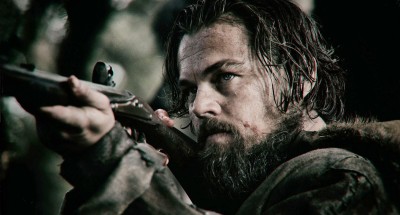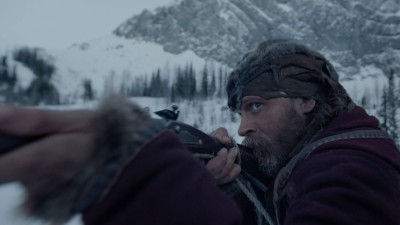
Revenant: 2.A person or thing reborn (Wiktionary).
Alejandro G. Iñárritu’s The Revenant is adapted from a novel that was based on real events, so it comes by its PR as ‘inspired by true events’ the long way round – but that does not lessen its impact.
The Revenant is a riveting tale of brutal survival and the desire for revenge. It is elegantly shot but the violence is brutal and the obstacles unrelenting. It may get Leonardo DiCaprio his long-deserved Oscar® – and it might give cinematographer Emmanuel Lubezki a shot at his third consecutive Oscar®.
DiCaprio plays Hugh Glass, a guide who is leading a group of trappers headed by Captain Andrew Harvey (Domhnall Gleeson) to safety after an ambush by Native Americans has killed over half of their complement.
Taking only the pelts they can carry – and hiding those they couldn’t – the survivors begin the trek back to their outpost. As Glass is scouting ahead, he spots a couple of grizzly bear cubs and, before he can defend himself, is attacked by their mother and savagely mauled before finally killing her.
Despite the mauling, he survives long enough to be found and stitched up, but as he hovers near death, carrying hinders the group’s progress. At the insistence of John Fitzgerald (Tom Hardy), Glass is left behind with Fitzgerald, Jimmy Bridger (Will Poulter) and Glass’ half-Pawnee son, Hawk (Forrest Goodluck) with orders to wait for him to succumb to his wounds and give him a proper burial.
Fitzgerald, who has spent most of his time bitching and moaning about one thing or another from the film’s opening moments, gets impatient and tries to hurry things along – killing Hawk and leaving Glass half buried before persuading Bridger that their attackers have found them and heading back to the fort.

The Revenant is primarily about Glass’ survival and efforts to track down Fitzgerald to wreak his vengeance, but the film also follows two other threads: Harvey’s men as return to base, and the efforts of a native leader, Elk Dog (Duane Howard) to find his daughter – who was kidnapped by white men.
Scripted by Iñárritu and Mark L. Smith, The Revenant is incredibly beautiful to look at – even in the goriest scenes – kind of like a Sam Peckinpah film. Cinematographer Lubezki captures the stark serenity of the Rocky Mountains and both the haunting beauty and danger of the pine forests and powdery snow that are everywhere in the film.
There are moments of great irony here, too – as when a native named Hikuc (Arthur Redcloud), who helps Glass, because he too has lost his family, comes to an ignominious end – that help Iñárritu build to a conclusion that twists everything we’ve seen Glass endure into an even more poetic bit of frontier justice.
Although DiCaprio is getting the lion’s share of notices for his portrayal of Glass (the moment when he talks about not being afraid of dying is powerful stuff), Hardy, Poulter and Gleeson all do outstanding work – and the key native cast is equally as good.
Iñárritu’s desire to shoot the film on beautiful but trying locations – and with only natural light – results in a film that has a very distinctive look. The soft gray skies provide an unexpected contrast to the blood and violence.
Between co-writing and directing, Iñárritu does a very nice job of keeping all the major supporting characters in the audience’s mind – even as he concentrates the majority of the film’s 156 minutes on Glass’ travails.
Despite the Cineplex Odeon chain reducing its large drinks by 30%, I still had a full third of my drink left as the credits began to roll – so yes, The Revenant is a great film.
Final Grade: A+